Discover 7 Unusual Foods Eaten for Good Luck Across the Globe
Welcome to a tasty tour where we explore seven unusual foods from different cultures that are believed to bring good luck and are enjoyed on special occasions. Discovering these unique dishes is not only a thrilling part of travel but also an insight into the traditions and beliefs that shape different cultures around the globe. So, let’s dive into the world of these fortunate foods and uncover the stories behind them!
- Hoppin’ John, a Southern New Year’s tradition, mixes black-eyed peas, rice, and pork for luck in the New Year.
- King Cake, enjoyed during Mardi Gras in Louisiana, is a sweet treat believed to bring good luck, with a hidden trinket inside.
- Tamales, a Mexican holiday staple, symbolize family and joy during the festive season.
- Soba noodles on New Year’s Eve in Japan represent a wish for a long and healthy life.
- Eating 12 grapes at midnight on New Year’s Eve in Spain is believed to bring good luck for each month of the year.
Hoppin’ John – A Southern New Year’s Tradition
One of the most popular good luck foods in the Southern United States is Hoppin’ John, a delicious dish made with black-eyed peas, rice, and pork that is traditionally enjoyed on New Year’s Day. This flavorful combination is believed to bring prosperity and good luck for the coming year.
Hoppin’ John has a rich history rooted in African and Caribbean traditions, brought to the region by enslaved Africans. The black-eyed peas in the dish symbolize coins or wealth, while the pork represents progress and forward movement. Rice is a staple food that signifies abundance and fertility.
To prepare Hoppin’ John, black-eyed peas are simmered with aromatic seasonings like onions, garlic, and bay leaves, along with ham hock or bacon to infuse the dish with smoky flavor. The peas are then served over steamed white rice, creating a hearty and satisfying meal.
This New Year’s Day tradition goes beyond the delicious flavors. It brings families and communities together, as they gather around the table to share in this symbolic meal. It is often enjoyed with collard greens, cornbread, and other Southern staples, creating a festive feast filled with hopes for a prosperous year ahead.
| Key Ingredients | Symbolic Meaning |
|---|---|
| Black-eyed peas | Wealth and coins |
| Pork | Progress and forward movement |
| Rice | Abundance and fertility |
“Hoppin’ John is a delicious and meaningful tradition that has been passed down through generations,” says Chef Samantha, a Southern cuisine expert. “The combination of flavors and the symbolism behind the ingredients make it a cherished part of our New Year’s Day celebrations.”
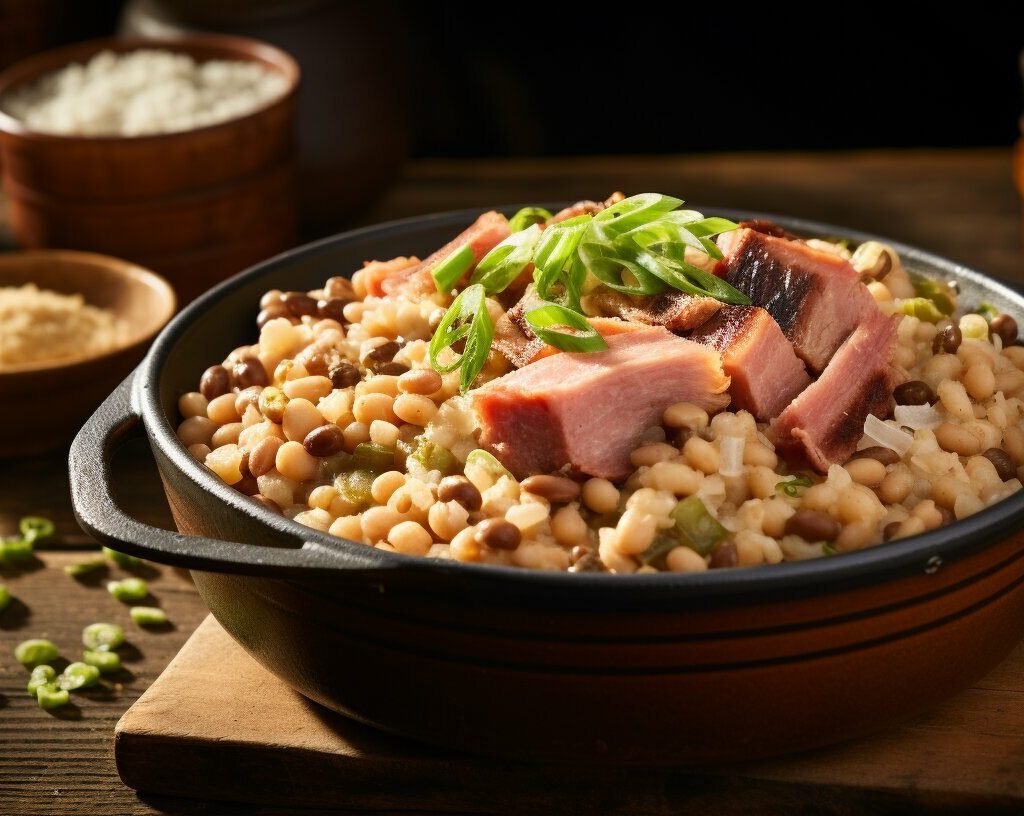
- Ingredients:
- 1 cup dried black-eyed peas
- 4 slices of bacon, chopped
- 1 medium onion, diced
- 2 cloves of garlic, minced
- 1 bay leaf
- 1 teaspoon salt
- 1/2 teaspoon black pepper
- 2 cups cooked white rice
- Instructions:
- Soak the black-eyed peas in water overnight, then drain.
- In a large pot, cook the bacon until crispy. Remove the bacon and set aside, leaving the bacon grease in the pot.
- Add the diced onion and minced garlic to the pot and sauté until fragrant.
- Add the soaked black-eyed peas, bay leaf, salt, and black pepper to the pot. Cover with water and bring to a boil.
- Reduce the heat, cover, and simmer for about 1 hour or until the peas are tender.
- Remove the bay leaf and stir in the cooked rice. Cook for an additional 5 minutes to allow the flavors to meld.
- Serve hot, garnished with the crispy bacon.
King Cake – A Lucky Treat from Louisiana
When it comes to lucky treats, few can compare to the vibrant and delicious King Cake, a festive dessert that holds a special place in the hearts of Louisianans during the Mardi Gras season. This iconic cake, adorned with colorful sugar and icing, is as beautiful as it is tasty. But what truly sets it apart is the hidden surprise tucked inside – a small trinket, often in the shape of a plastic baby, symbolizing luck and prosperity.
King Cake is deeply rooted in Louisiana’s rich cultural heritage and tradition. It is typically enjoyed from January 6th, also known as Epiphany or Twelfth Night, until Mardi Gras, which falls on the day before Ash Wednesday. During this time, locals gather with family and friends to savor each slice of the cake, hoping to be the lucky one to find the hidden trinket. According to custom, the person who discovers the trinket is not only blessed with good luck but also becomes the ‘king’ or ‘queen’ of the celebration, responsible for hosting the next King Cake party.
The origins of King Cake can be traced back to medieval Europe, where it was associated with the celebration of Epiphany. As Christianity spread across the world, the cake found its way to Louisiana through French and Spanish settlers. Over the years, King Cake has become an integral part of Mardi Gras festivities, symbolizing the joy, abundance, and sense of community that define this vibrant cultural event.

King Cake not only brings joy and sweetness but also carries a deeper meaning. The three colors used to decorate the cake – purple, green, and gold – hold symbolic significance. Purple represents justice, green symbolizes faith, and gold signifies power. These colors adorn the cake in the form of sugar, icing, or even colored dough, adding a touch of magic and symbolism to every bite.
Sharing a slice of King Cake has become a beloved ritual in Louisiana, bringing people together and fostering a sense of unity and community. It is a celebration of Louisiana’s diverse cultural heritage and the spirit of Mardi Gras, where people gather to enjoy good food, music, and dance in the spirit of camaraderie and goodwill.
A Lucky Tradition Worth Savoring
Whether you find the trinket or not, every bite of King Cake is a reminder of the traditions and values that make Louisiana so special. This delectable treat is not just a dessert; it is a symbol of luck, heritage, and the spirit of celebration. So, as you indulge in the flavors of King Cake, remember the vibrant history behind this time-honored tradition and the hope it brings for a fortunate year ahead.
Tamales – Symbolizing Family and Holiday Joy in Mexico
In Mexico, tamales are not just a delicious dish but also a symbol of family unity and holiday joy, enjoyed during festive seasons like Christmas and New Year. These humble bundles of masa, steamed to perfection and filled with a variety of savory fillings, hold a special place in Mexican culture and traditions.
Click Here To Buy Our Healthy Cookbook For Only $27 Today!During the holiday season, families gather around the kitchen to prepare tamales together, turning it into a joyful and communal affair. The process of making tamales, from preparing the masa to filling and wrapping them in corn husks, is a labor of love that brings generations together and strengthens family bonds.
Traditionally, tamales are made in large batches, ensuring that there are plenty to share with family, friends, and even neighbors. They are often served as the centerpiece of festive meals, accompanied by Mexican staples like rice, beans, and salsa. Each bite of a tamale is a celebration of flavors and traditions, reminding us of the importance of family and the joy of coming together.
The Joy of Sharing Tamales: A Mexican Tradition
Tamales are not only enjoyed during the holiday season but also on other special occasions throughout the year. From birthdays to weddings, tamales are often present on the menu, symbolizing the importance of sharing and celebrating with loved ones.
They are also an integral part of Mexican culture and are deeply rooted in ancient traditions. In fact, tamales date back thousands of years to the time of the Aztecs, who considered them a sacred food. Today, tamales continue to be cherished and enjoyed, keeping the spirit of tradition alive.
So, the next time you savor a tamale, take a moment to appreciate the love, history, and traditions that go into making this iconic Mexican dish. Enjoy the flavors, share the joy, and embrace the sense of family unity and holiday cheer that tamales bring.
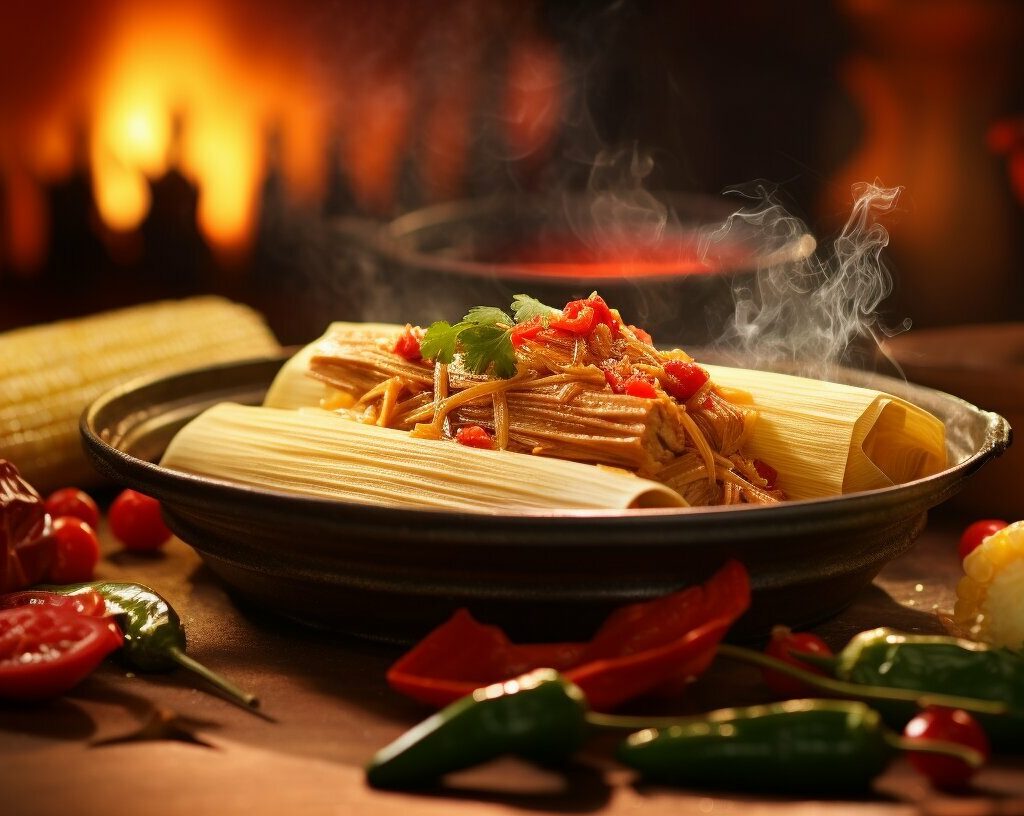
| Tamales | Symbolism |
|---|---|
| Family Unity | Tamales being prepared and enjoyed together symbolize the importance of family unity and togetherness. |
| Holiday Joy | Tamales are a delicious and festive treat that brings joy to Mexican households during the holiday season. |
| Ancient Tradition | Tamales have deep roots in ancient Mexican traditions, dating back to the time of the Aztecs. |
| Sharing and Celebration | Tamales are often shared and enjoyed during special occasions, symbolizing the importance of sharing and celebration with loved ones. |
Soba Noodles – A Japanese Tradition for Longevity
As the clock strikes midnight on December 31st in Japan, many people indulge in a steaming bowl of soba noodles, not just for its delectable taste but also for the hopeful promise of a long and prosperous life. Soba noodles, made from buckwheat flour, have been a beloved part of Japanese cuisine for centuries and are particularly significant during the New Year’s Eve celebration.
These thin, brownish noodles are often served in a hot broth or chilled with a dipping sauce. The length and resilience of the soba noodles are believed to symbolize a long and healthy life. It is common to see families and friends gathering around the table, slurping up the noodles together, fostering a sense of togetherness and hope for the coming year.
“Eating soba noodles on New Year’s Eve has been a cherished tradition in our family for generations,” says Hiroshi Tanaka, a Tokyo native. “It brings us closer together and reminds us of the importance of health and longevity. Plus, it’s absolutely delicious!”
To add to the festive spirit, soba noodles are sometimes adorned with symbolic toppings like tempura flakes, green onions, or seaweed. These toppings not only enhance the taste but also add visual appeal to the dish. The act of eating soba noodles is considered an auspicious way to bid farewell to the old year and welcome the new one with open arms.
The Significance of Soba Noodles
Soba noodles hold a special place in Japanese culture, with their preparation and consumption associated with various rituals and beliefs. The length and thinness of the noodles are said to represent the shedding of the past year’s hardships and the hope for a smooth journey into the future. It is customary to eat the soba noodles without breaking or biting them, as this is thought to bring bad luck and interfere with the desired longevity.
As New Year’s Eve approaches, soba noodle shops and restaurants are filled with eager diners, eager to partake in this time-honored tradition. The popularity of soba noodles during this festive time reflects the deep-rooted belief in their power to bring good fortune, health, and happiness in the coming year.
| Toppings | Symbolic Meanings |
|---|---|
| Tempura flakes | Prosperity and abundance |
| Green onions | Growth and renewal |
| Seaweed | Good luck and protection against evil spirits |

As midnight approaches, the clinking of chopsticks against bowls resonates across Japan as people eagerly devour their soba noodles, believing that each swallow brings them closer to a fulfilling and prosperous future. Whether enjoyed at home or in bustling noodle shops, the tradition of eating soba noodles on New Year’s Eve is a heartwarming reminder of the power of hope, unity, and the enduring appeal of cultural traditions.
12 Grapes – Spanish Tradition for Year-Round Good Luck
In Spain, the New Year’s Eve celebration is incomplete without the ritual of devouring 12 grapes, symbolizing hope for good luck and prosperity in the months to come. As the clock strikes midnight, Spaniards across the country pop one grape into their mouths with each chime, aiming to finish all 12 before the final stroke of midnight. This age-old tradition is believed to bring good fortune for each month of the year, ensuring a prosperous and successful future.
The custom of eating 12 grapes originated in the early 20th century in the region of Alicante, where vineyards flourished. As the story goes, grape growers had a surplus harvest one year and, in a bid to boost sales, started promoting the idea of consuming 12 grapes at midnight. The practice quickly caught on and became a cherished tradition that has endured to this day.
This delightful tradition is not only esteemed for its symbolism but also for its entertainment value. Families and friends gather around the television on New Year’s Eve to watch the live broadcast from Puerta del Sol in Madrid, where the clock tower counts down the seconds and prompts everyone to consume their grapes in unison. It is a joyous and whimsical moment that adds charm and excitement to the New Year’s Eve festivities.

As you savor each grape, take a moment to reflect on the year gone by and the possibilities of the year ahead. The sweetness of the grapes symbolizes the hope for a year filled with joy and abundance, while the act of eating them together signifies unity and togetherness. It is a time-honored tradition that brings people closer and fosters a sense of community as they welcome the New Year with open hearts and, of course, delicious grapes.
| Grape Varieties | Region |
|---|---|
| Aledo | Murcia |
| Perlette | Catalonia |
| Albarín | Asturias |
“Eating the 12 grapes at midnight is an exciting tradition that fills us with hope and expectation for the year ahead. It’s a fun way to celebrate with loved ones and embrace the possibilities of the future.” – Maria, a Spaniard who eagerly participates in the grape-eating tradition every New Year’s Eve.
Lentils – A Prosperity Symbol on Italian Tables
In Italy, lentils take center stage on New Year’s Eve, where they are believed to bring good fortune and prosperity for the upcoming year and are traditionally served alongside savory pork sausage. This humble legume holds great significance in Italian culture, symbolizing wealth and abundance.
The tradition of eating lentils on New Year’s Eve dates back to ancient times. It is believed that the round shape of lentils resembles coins, representing financial prosperity. By consuming lentils, Italians hope to attract wealth and good luck in the coming year.
To fully embrace the Italian tradition, a hearty dish called “Cotechino con Lenticchie” is prepared. Cotechino, a type of Italian pork sausage, is simmered until tender and served with a generous portion of lentils. The combination of flavors and textures is a delight to the palate, and it is said that the more lentils you eat, the more prosperity you will experience in the year ahead.
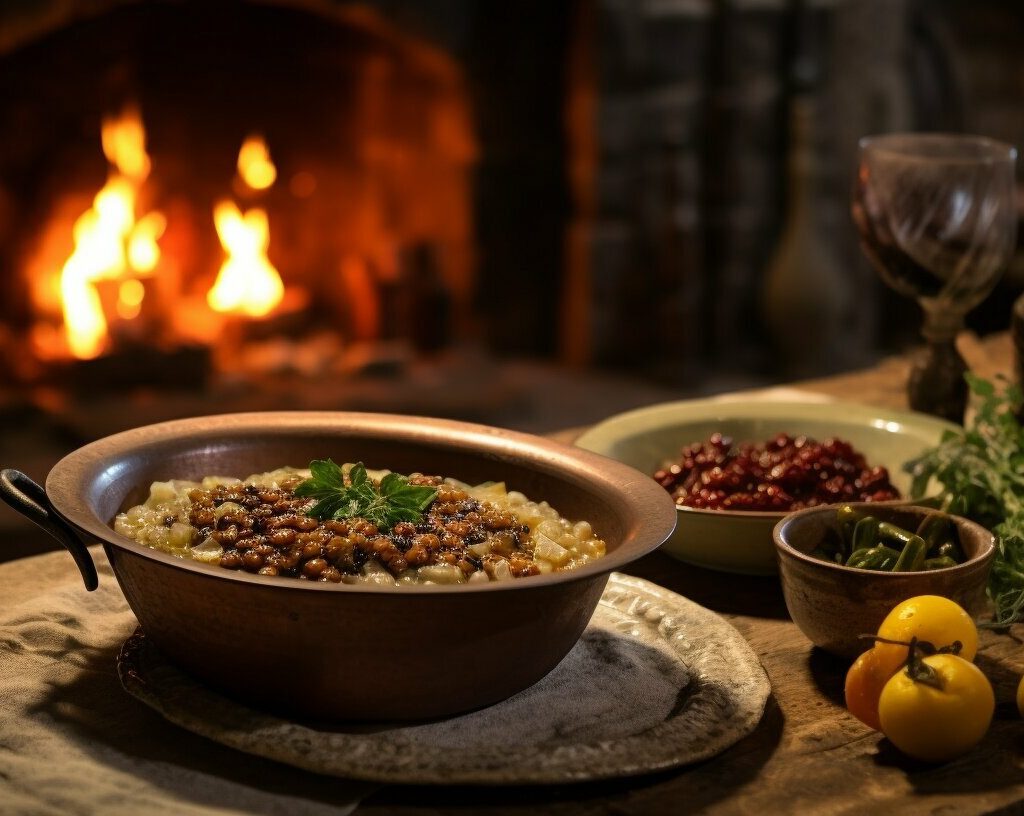
This Italian tradition showcases the importance of food in cultural celebrations. Whether it’s a simple bowl of lentils or an elaborate feast, these culinary rituals bring people together, fostering a sense of community and hope for a prosperous future.
| Italian Tradition | Symbolism |
|---|---|
| Lentils | Wealth and abundance |
| Pork Sausage (Cotechino) | Savory flavors and good luck |
As we celebrate the New Year, let us embrace the traditions of different cultures and the symbolic meaning behind the foods we consume. From lentils in Italy to hoppin’ John in the Southern United States, these unusual foods bring hope, joy, and the promise of a prosperous year ahead.
Pickled Herring – Fertility and Bounty in Northern European Cultures
Northern European cultures have long celebrated the arrival of a new year by partaking in a delicious feast featuring pickled herring, a dish believed to bring forth fertility, abundance, and a bountiful year ahead. This traditional dish holds deep cultural significance, symbolizing the hopes and aspirations for the coming year. In Scandinavian, German, and Polish cultures, pickled herring takes center stage on New Year’s Eve, often served as part of a festive smorgasbord.
The unique flavor and texture of pickled herring have made it a beloved delicacy across these regions. Herring, a nutritious and bountiful fish in the Baltic Sea, is harvested abundantly during the winter months, making it readily available for the New Year’s festivities. The pickling process, which involves marinating the fish in a brine of vinegar, sugar, and spices, not only preserves it but also imparts a tangy and savory flavor that is both delightful and addictive.
As a symbol of fertility, pickled herring is believed to bring forth prosperity and abundance in the coming year. Its association with fertility can be traced back to ancient times when the herring’s bountiful nature and mating rituals were seen as a sign of abundance and new beginnings. Today, the tradition continues as families gather around the table, savoring the taste of pickled herring and sharing stories of hope and good fortune.
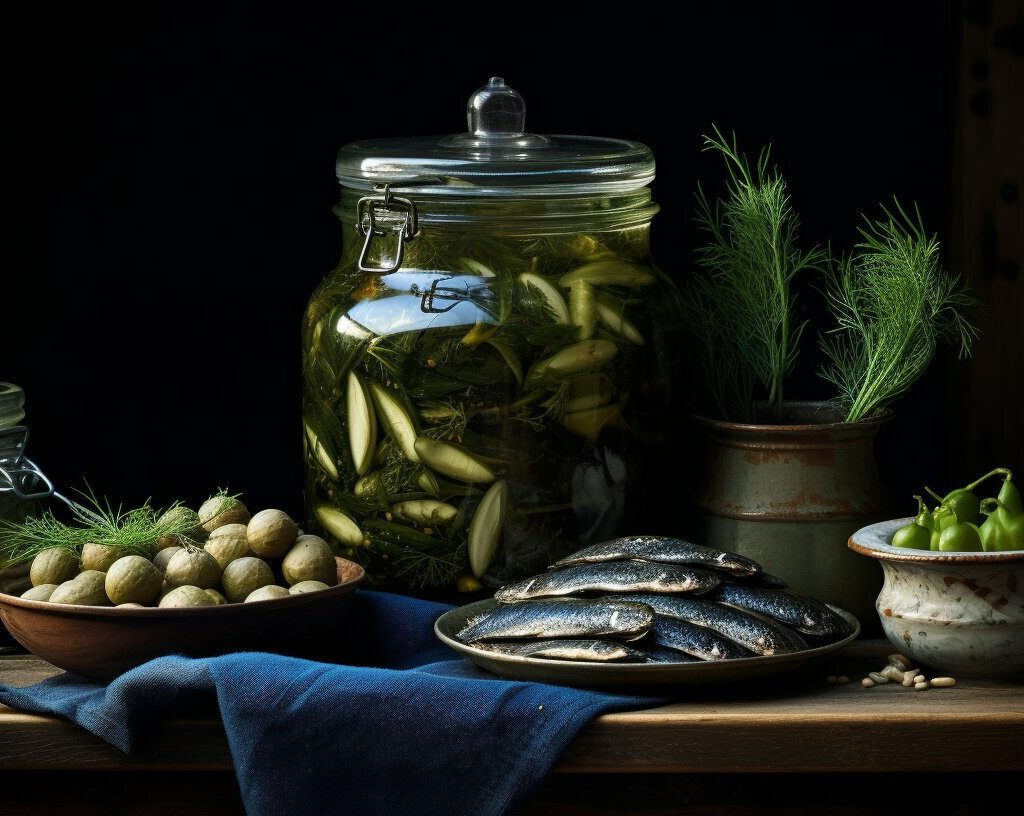
Whether enjoyed on its own, atop a slice of dark rye bread, or as a complement to other traditional dishes, pickled herring remains a beloved culinary tradition. Its presence at the New Year’s table is a reminder of the deep-rooted cultural heritage and the shared belief in the power of food to bring luck, prosperity, and a flourishing year ahead.
| Benefits of Pickled Herring |
|---|
| Rich in omega-3 fatty acids |
| Excellent source of protein |
| High in vitamins D and B12 |
| Contains essential minerals, such as selenium and phosphorus |
So, as you celebrate the arrival of the new year, consider embracing the tradition of pickled herring. Not only will you enjoy a delicious and unique dish, but you will also partake in a cultural experience that embodies hope, fertility, and the promise of a prosperous year ahead. Cheers to a bountiful new year!
Pork and Sauerkraut – A Pennsylvania Dutch Tradition
In Pennsylvania Dutch households, the start of a new year is marked by a hearty feast of pork and sauerkraut, a delicious tradition believed to bring good luck, progress, and prosperity. This unique combination of flavors has deep cultural roots and is cherished by the community. As a journalist with a passion for exploring different culinary traditions, I was intrigued to learn more about this Pennsylvania Dutch custom.
The dish typically consists of slow-cooked pork shoulder, tender and succulent, served alongside tangy sauerkraut, fermented cabbage that adds a distinct taste and texture. The combination signifies a year filled with abundance and growth. The pork symbolizes progress, moving forward into the new year, while the sauerkraut represents good luck and prosperity.
The Pennsylvania Dutch believe that eating pork and sauerkraut on New Year’s Day will bring blessings and fortune for the entire year. It is said that the long strands of sauerkraut represent a long life, and the pork, when cooked low and slow, symbolizes wealth and prosperity. The flavors meld together beautifully, creating a harmonious balance that is both comforting and satisfying.
As I reflect on this unique tradition, it reminds me of the importance of cultural heritage and the role that food plays in bringing communities together. Whether it’s Hoppin’ John, King Cake, Tamales, or Soba Noodles, every culture has its own special foods believed to bring good luck and fortune. These unusual dishes not only tantalize the taste buds but also carry the hopes and dreams of those who enjoy them.
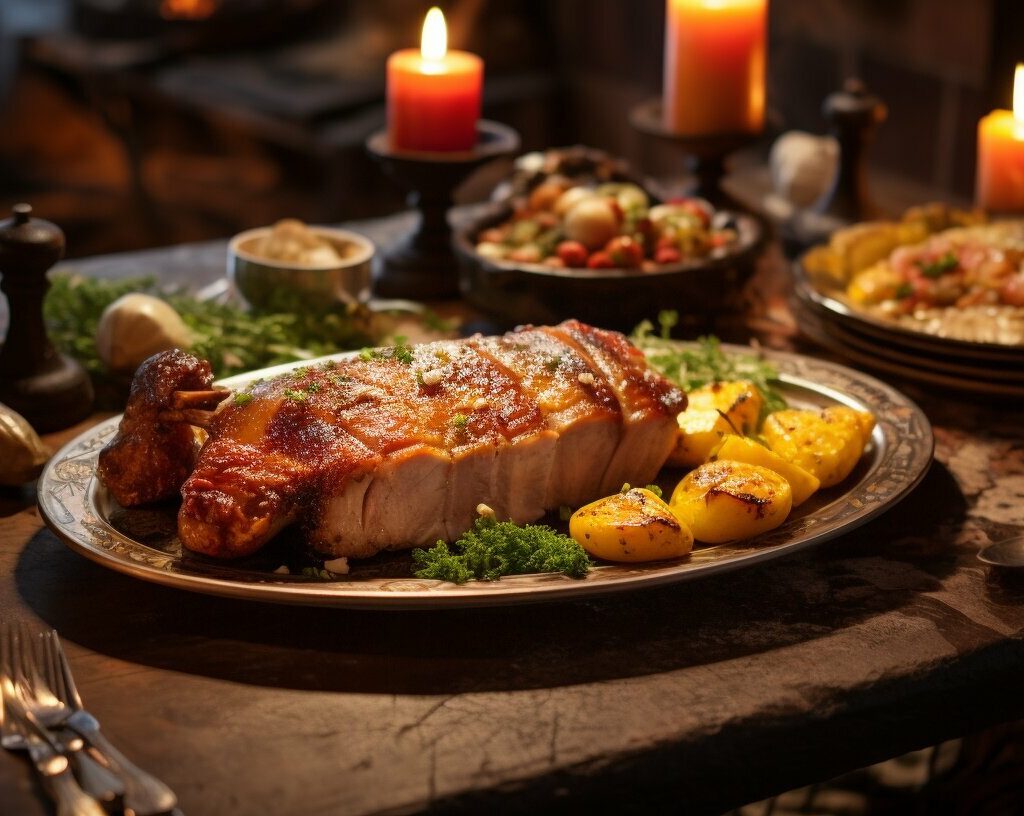
| Symbol | Description |
|---|---|
| Pork | Symbolizes progress, moving forward into the new year |
| Sauerkraut | Represents good luck and prosperity |
“In Pennsylvania Dutch households, pork and sauerkraut is more than just a meal; it’s a cherished tradition that brings our community together and sets the tone for a prosperous year ahead.” – Mary Miller, Pennsylvania Dutch resident
So, if you find yourself in Pennsylvania on New Year’s Day, be sure to partake in this flavorful tradition. Indulge in a plate of tender pork and tangy sauerkraut, savoring the tastes that have been passed down through generations. And as you enjoy each bite, remember the rich symbolism behind this beloved Pennsylvania Dutch dish and the hope it brings for a fortunate year ahead.
Conclusion
As we conclude our tasty tour, we are reminded of the fascinating traditions and symbolism behind these unusual foods enjoyed for good luck, and the shared belief in the possibility of a prosperous year ahead.
From Hoppin’ John in the American South to King Cake in Louisiana, tamales in Mexico to soba noodles in Japan, and 12 grapes in Spain to lentils in Italy, these diverse dishes not only tantalize our taste buds but also carry rich cultural significance.
Whether it is the hope for a year filled with abundance, good health, longevity, or prosperity, these unusual foods bring a sense of optimism and tradition to special occasions.
So, as we savor the flavors of these unique delicacies, let us raise a toast to the power of food to connect us to different cultures, and to the belief that with a little luck on our plates, the year ahead holds great promise.
World Trade Center Footage | Webex Costs | Virtual Data Rooms | Structures Annuity Settlement | Sell Annuity Payment | Neuson | Online Classes | Nunavut Culture | Online College Course | Motor Replacements | Motor Insurance Quotes | Mortgage Adviser | Met Auto | Tax credit | Help desk software | Home refinancing | Urgent care | Marketing integration | Debt relief | Bitcoin | Fitness center software | Insurance | Gas | Electricity | Weight loss | Sell house for cash | Automotive repair | Loans | Internet marketing | Mortgage | Attorney | SEO specialist | Lawyer | Donate | Conference Call | Treatment | Degree | Software | Credit | Classes | Investing | Recovery | Trading | Rehab | Hosting | Cord Blood | Claim | Automotive warranty | Paintless dent repair | Mesothelioma Law Firm | Massage School Dallas Texas | Low Credit Line Credit Cards | Life Insurance Co Lincoln | Insurance Companies | Injury Lawyers | How to Donate A Car in California | Home Phone Internet Bundle | Holland Michigan College | Royalty-Free Images Stock | Register Free Domains | Psychic for Free | Ph.D. in Counseling Education | Personal Injury Lawyers | Personal Injury Law Firm | PaperPort Promotional Code | Online Stock Trading | Online Motor Insurance Quotes | Donate your Car for Money | Online Colleges | Health Records, Personal Health Record | Hard drive Data Recovery Services | Donate Old Cars to Charity | Forex Trading Platform | Forensics Online Course | Donate Car to Charity California | Donate Car for Tax Credit | Car Insurance Quotes PA | Email Bulk Service | Donating Used Cars to Charity | Donating a Car in Maryland | Donate Your Car Sacramento | Online Criminal Justice Degree | Donate Your Car for Kids | Futuristic Architecture | Donate Cars in MA | Data Recovery Raid | Mesothelioma | A car accident lawyer | Personal injury lawyer | AC repair | Lawsuit settlements | Car insurance | Flood recovery | Water damage restoration | Rehab doctors | Online degree | Online master’s degree | Doctoral programs | Hail car insurance
